A growing number of RV enthusiasts are hunting down history in off-highways vehicles
For Terry Saar and his wife, Kae, there’s no better way to spend the summer than salmon fishing on Alaska’s Kenai Peninsula. But during the winter months, the Saars park their 33-foot Cardinal fifth-wheel at Black Rock RV Village in the tiny town of Brenda, Arizona, about 17 miles east of the snowbird mecca of Quartzsite. Then, perhaps once or twice a week, the Saars take off with friends in their small, two-seat off-road vehicle to explore abandoned gold mines, hidden canyons with ancient petroglyphs and other historical sites, some of which you won’t find on modern topographical maps.
“It’s a fascinating lifestyle,” said Saar, who lived in Port Angeles, Washington, before becoming a full-time RVer. The Saars are among a growing number of snowbirds who flock to southwestern Arizona during the winter months to explore the desert’s back roads and jeep trails in all-terrain vehicles.
The Saars have a Polaris RZR 800 side-by-side, which is capable of navigating dirt routes through deeply cut flash-flood washes and up steep, uneven trails with loose rocks that could easily intimidate those who aren’t used to traveling rough roads. “You learn how to drive these roads little by little,” said Saar. “I learned by following the guys who knew what they were doing.”
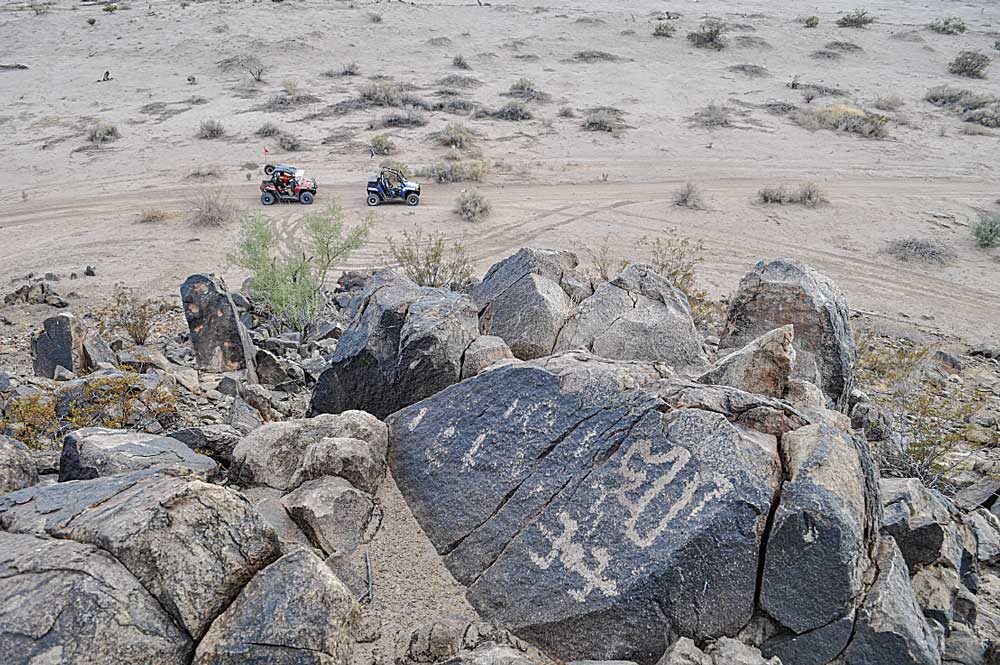
Petroglyphs decorate the rocks on numerous remote hillsides north of Gila Bend that snowbirds can see when they explore the desert in their off-road vehicles.
Visiting campgrounds and RV parks in remote areas of Arizona, you see lots of RVers with off-road vehicles. But spend a little time with them, and you learn that many didn’t start living the snowbird lifestyle with the idea of off-roading. Rather, they got into it after developing friendships with other RVers who have a passion for exploring places that are off the beaten track.
Most people never see many of the historical sites that surround them because they are too busy with their day-to-day lives. But snowbirds can make time to see these places. And if they have off-road vehicles, they can take it a step further and see historical sites that are not recorded on the latest topographical maps or maps produced by the U.S. Bureau of Land Management.
That’s the conclusion of Warren Rhyner, a snowbird from Altoona, Pennsylvania, who has spent the past eight winters exploring southwestern Arizona’s back roads in a Can-Am Maverick X3. Rhyner has found that maps made in the early 1900s are best for identifying early roads used by miners, pioneers and others who lived and worked in the Arizona desert a century or more ago. More recent maps do not show some of these routes, which adventuresome snowbirds discover as they follow BLM roads and ATV trails across the desert.
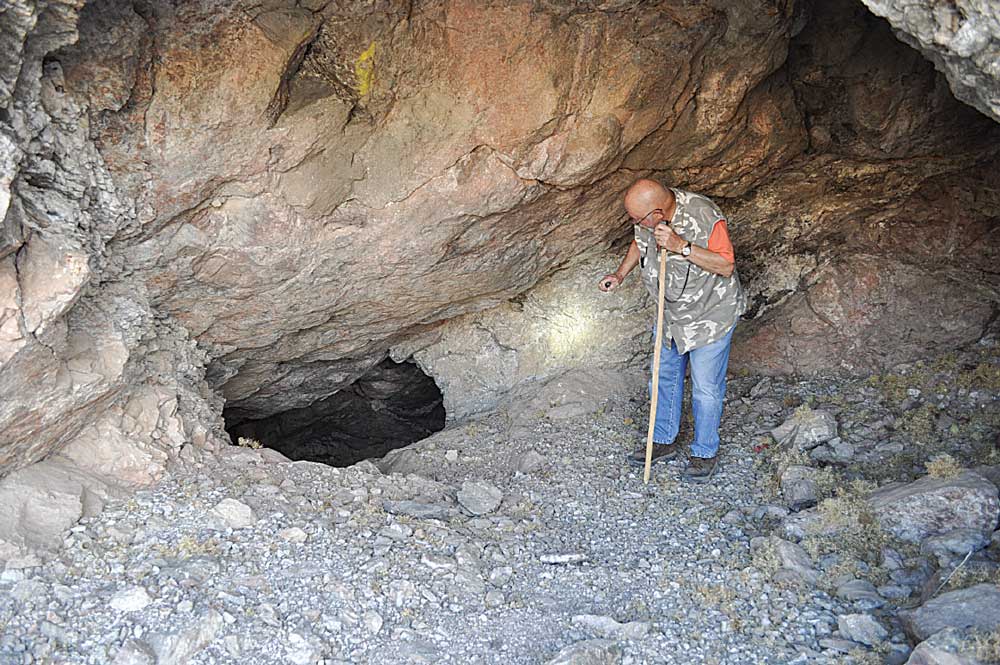
Bill Gelhaus explores an old abandoned mine in the Granite Wash Mountains near the town of Brenda.
“In the desert, the trails are visible, even if they haven’t been used in 10 or more years,” said Rhyner, who spends the winters at Black Rock RV Village with his wife, Mary. “Some roads haven’t been used for many years, but they remain perfectly preserved in the desert,” added Rhyner, who plots his routes using Google Earth and Garmin mapping software.
RVs and ATVs
Originally from Hartford, Connecticut, Ted Werner and his wife, Jan, are full-timers who park their 38-foot fifth-wheel about 120 miles away at the KOA in Gila Bend, which they use as a winter base camp while exploring the Butterfield Overland Mail Route, also known as the Butterfield Trail, and other historical sites in their Polaris Ranger.
“In the Gila Bend area,” Werner said, “we have the original Indian travel routes, the Juan Bautista de Anza Historic Trail, the Southern Emigrant Trail, the route used by the Mormon Battalion and the historic Butterfield Trail. There are places where we can see the wagon ruts in the rock, so you can very clearly see where they went through. In our travels, we’ve also seen artifacts from the Native Americans as well as the miners.”
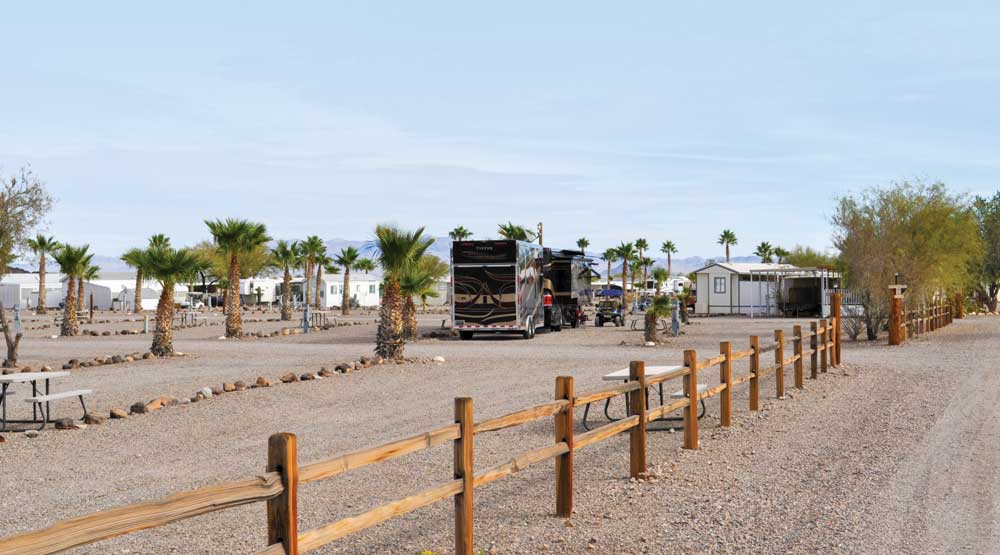
Black Rock RV Village, a Good Sam Park in Brenda, Arizona, welcomes snowbirding RVers and their ATVs for the winter.
On one recent trip, Werner and his friends visited a section of the Butterfield Trail near the Gila River. Stagecoach drivers used the route to carry passengers and mail across the country, from St. Louis to San Francisco, before the transcontinental railroad lines were constructed.
Even today, more than 150 years after the heyday of the Butterfield Trail, you can see it clearly through the desert, including the depressions in the rocks that were worn down by the passing of countless horse-drawn wagons with their steel-rimmed wheels. “It is fascinating to see the evidence of the people who came before us,” said Werner, a retired high school teacher.
One noteworthy historical site near Gila Bend that can be reached only by using dirt roads is the site of the Oatman Massacre. A sign erected by the Yuma County Historical Society marks the location and the date, February 18, 1851, when most of the Oatman family was massacred by Native American warriors in an attack that made national headlines while dramatizing the dangers that emigrants faced as they traveled out West.
According to historical accounts, Royce and Mary Oatman were traveling in a covered wagon with their seven children and had just climbed a steep road up a bluff overlooking the Gila River when they were attacked. There is some discussion about whether the Oatman family was ambushed by Apaches or a band of Yavapai Indians known as the Tolkepayas, but the attackers killed Royce and Mary and four of their children, and took their daughters, 14-year-old Olive and seven-year-old Mary Ann, into captivity. Their son, Lorenzo, survived the attack and spent years looking for his sisters.
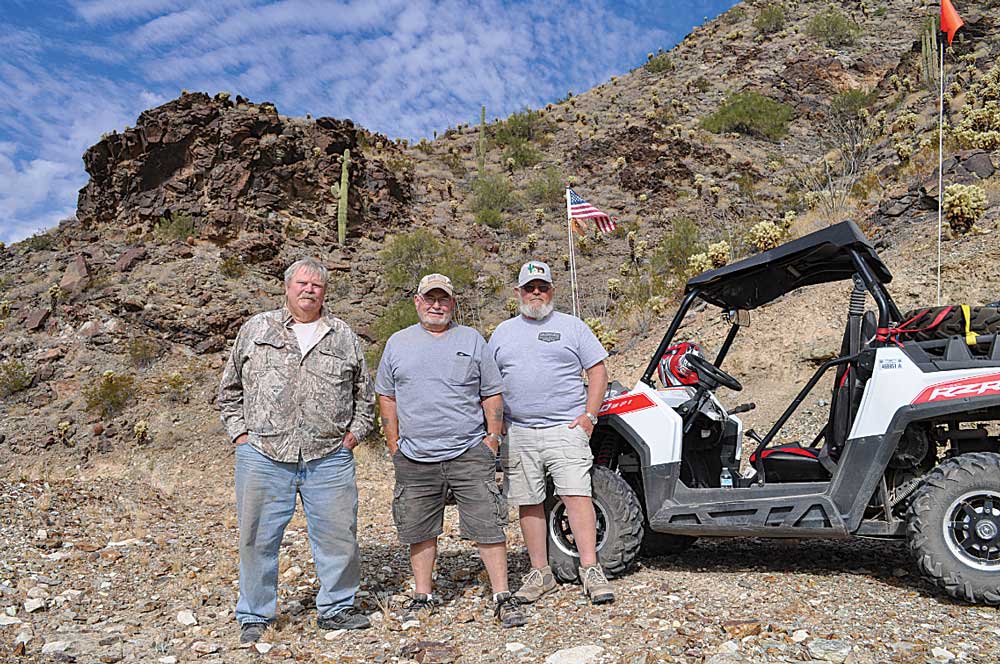
Saar (pictured on the left) joins fellow off-road enthusiasts Dave Weber (center) and Bob Hawley (right) spending the winter at Black Rock RV Village.
The two young girls were held as slaves and were eventually traded to a Mohave tribe, who gave them blue tattoos on their faces and arms. Historical accounts say Mary Ann likely died during an extreme drought, while Olive was eventually delivered back to white settlers at Fort Yuma in 1856. Olive became something of a celebrity and went on a speaking tour to promote a book about her experiences.
Bygone Trails
Snowbirds often do their research online and use libraries to gather additional details about the historical sites in the areas they want to visit. Werner said he has found a couple of books to be extremely helpful, including Guide to Arizona Backroads & 4-Wheel-Drive Trails by Charles A. Wells and Matt Peterson.
Snowbirds staying at Gila Bend KOA recently learned even more when historian Gerald Ahnert visited the campground and took several of them on an impromptu tour. Ahnert, who wrote two books about the Butterfield Trail, led the Werners and several of their friends down the road that leads to the site of the Oatman Massacre.
It was on that tour that Ahnert pointed out the location of an abandoned emigrant camp, which lies hidden in plain sight along the dirt road leading to the Oatman Massacre Site. “Most people don’t see it,” Werner said, “because they don’t know what to look for.”
The emigrant camp includes the rusting remnants of tin cans and broken glass from 100-plus-year-old containers used by emigrant families as they traveled westward to California. “Some of the cans were sealed with lead,” Werner said, pointing to the outlines of the cans during a recent visit to the site. “That was before they knew lead was poisonous.”
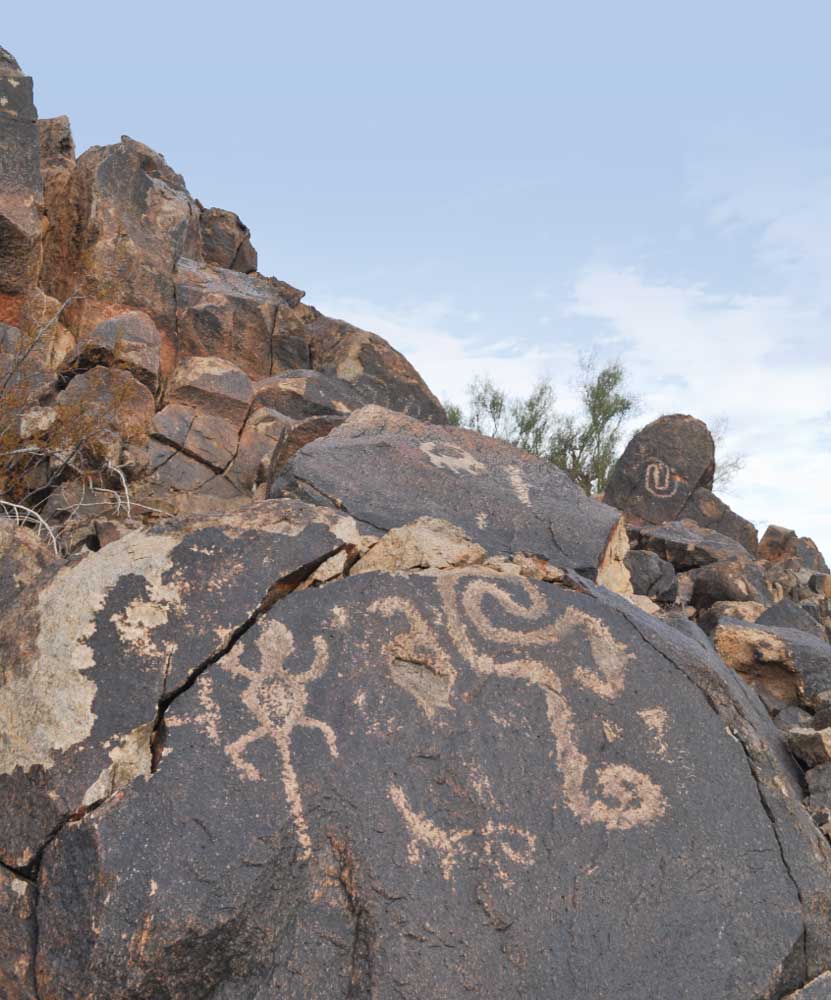
Traversing rough desert routes is necessary to reach ancient petroglyphs north of Gila Bend.
The camp also includes an unmarked grave, which is visible only because it features a row of carefully set volcanic rocks of roughly the same size. The identity of the person buried remains a mystery, much like many of the unmarked graves that snowbirds discover in their travels across the Arizona desert. But as interesting as these historical sites are, Werner advises visitors not to touch anything and to leave the historical evidence
as it is for others to see.
Saar and his friends at Black Rock RV Village have a similar philosophy and use great care as they explore their desert surroundings because they want to ensure that it remains preserved for others to enjoy. And while they love to explore dirt roads that do not appear on modern maps, they are also careful not to drive off-trail because they don’t want to mar the desert landscape.
Traveling these back roads with Werner, Saar and other snowbirds, one realizes that the many areas of the southwestern Arizona desert are like the open pages of a history book that are just waiting to be discovered. Snowbirds exploring Arizona’s back roads can even discover written historical records in the form of ancient petroglyphs, which can be found in numerous locations. Werner said The Rocks Begin to Speak, a guide to understanding Indian rock writing by Lavan Martineau, is a helpful resource for petroglyph enthusiasts.
Native Americans also left behind other records of their existence, including dwellings and battlefield structures. One defensive area, called Fortaleza, can be seen from a dirt road a few miles north of Gila Bend. The protective walls that once shielded Native American Indians from attack can be seen on top of a mountain. But most people traveling Interstate 8 or State Route 85 from Gila Bend to Buckeye would never know these historical structures exist.
Mines and Minerals
As one might expect, the mines and tailing piles that are strewn across southwestern Arizona are of particular interest to rock hounds, including Bill Gelhaus, an RV snowbird from Wisconsin who spends the winter at Black Rock RV Village with his wife, Judy.
The Gelhauses sold their 2,300-square-foot home in 2005 and have been full-time RVing ever since in their 40-foot motorhome. The couple explores Arizona’s backcountry in an orange 1968 Volkswagen Baja Bug with a powerfully modified engine. They
affectionately call it Ladybug.
Bill Gelhaus estimates they have logged more than 10,000 miles exploring Arizona’s jeep trails during the past 11 years. That amounts to nearly 1,000 miles each winter. But he said they are still a long way from seeing everything there is to see. “You can be like a history hunter,” Gelhaus said. “You’re traveling back into the late 1800s and early 1900s.”
The Gelhauses also love to revisit their favorite places each winter, especially abandoned gold mines in the Jewel Anne Mine Group in the Granite Wash Mountains. “There are mines you can see with mine shafts and tunnels,” Gelhaus said, adding that an online mineral and rock database on www.mindat.org provides information and locations of old mines in Arizona and other states across the country.
The Gelhauses sometimes pick through abandoned tailing piles, which contain quartz and other types of rock that they polish into jewelry and centerpieces. In their travels across the desert, the Gelhauses have also found “Apache tears,” small dark brown or black polished obsidian stones that are slightly transparent. Some people believe the stones have healing properties.
In addition to seeing historical sites, the Gelhauses like to travel with friends into remote scenic areas, including Red Rock Canyon, a slot canyon with 40-foot-high walls that is about 75 miles northeast of Black Rock RV Village.
But while there are many enticements in the barren desert and mountain areas of southwestern Arizona, these snowbirds are careful to travel in groups for safety. They make maps of their routes and carry walkie-talkies to remain in communication with each other when mobile phones are out of range.
Driving across the desert, they say, it’s easy to lose sight of each other behind thick stands of palo verde and ironwood trees. There are also plenty of hazards, including sharp rocks and creosote bushes that can puncture the thickest tires. “We also see gila monsters and rattlesnakes,” Rhyner added.
But there is tremendous beauty in Arizona’s desert, too, including desert sheep, spring wildflowers and the majestic saguaro cactus.
Discovering the Desert
Werner said during the middle of winter there will be 18 or more couples with ATVs at the Gila Bend KOA. Black Rock RV Village has even more, probably 20 to 25, according to Gelhaus. But ATV enthusiasts at both parks typically break into smaller caravans when they do their tours, partly to keep the dust down but also to minimize delays as they travel.
Most of them drive out into the desert frequently, usually at least two to three times a week. When they go, they typically make a day out of it, taking along plenty of water, snacks and a picnic lunch. Saar brought along smoked salmon from his latest trip to Alaska that he shared with friends during one recent trip into the Granite Wash Mountains.
Snowbirds say ATV rides are a nice complement to the other social activities they enjoy with friends at RV parks and campgrounds. And when newcomers arrive at these parks, some of them find they can’t resist the temptation to buy their own ATV and join in the fun. That’s how the Saars got hooked.
Ted and Jan Werner never dreamed they would be ATVers, either. Both are hikers, and they thought they could get wherever they needed to go on foot. But after spending time in the Arizona desert, they soon realized they needed an ATV to be able to visit some of the places they most wanted to see.
The Werners go back to New Hampshire each summer to visit their children and grandchildren, as they have every year since they started full-time RVing in 2010. But in winter, you’ll find them out riding with friends in their ATVs, looking to turn more pages of history in the Arizona desert.
“Every time I go out,” Ted Werner said, “I see something new or something from a different perspective.”
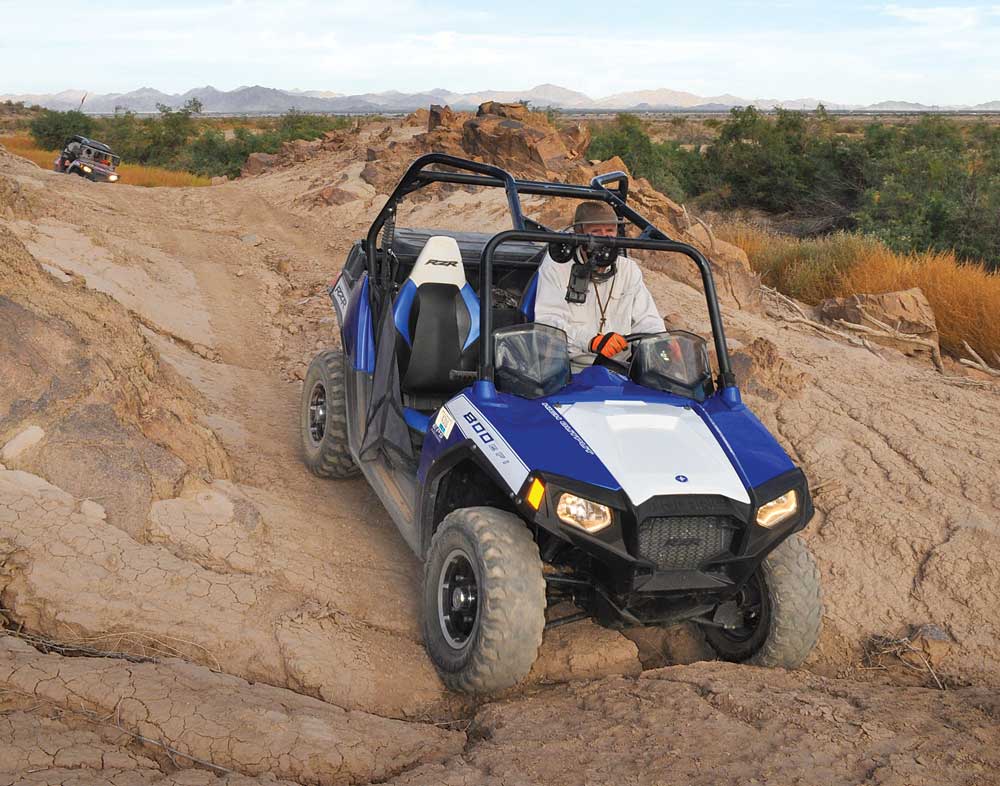
Ted Werner traverses rough desert routes in his Polaris Ranger.
Where to Stay in Arizona’s Outback
Located off Interstate 10 on U.S. Route 60 in Brenda, Black Rock RV Village offers 408 full-hookup sites, a winter activity program and amenities that include a café, an outdoor pool, an 18-hole pitch-and-putt course, horseshoe pits, a library, laundry facilities and free Wi-Fi. The pet-friendly Good Sam Park received the 2017 Large Park of the Year Award from the Arizona Association of RV Parks and Campgrounds.
928-927-4206 | www.blackrockrv.com
 Just off Interstate 8, Gila Bend KOA in Gila Bend has 130 roomy full-hookup sites, a new outdoor swimming pool, laundry facilities, limited Wi-Fi and a 4,000-square-foot dog park with three corrals. The RV park received KOA’s Founders Award in 2017 and was ranked 55 out of the 500 KOAs, based on guest-satisfaction surveys.
Just off Interstate 8, Gila Bend KOA in Gila Bend has 130 roomy full-hookup sites, a new outdoor swimming pool, laundry facilities, limited Wi-Fi and a 4,000-square-foot dog park with three corrals. The RV park received KOA’s Founders Award in 2017 and was ranked 55 out of the 500 KOAs, based on guest-satisfaction surveys.
928-683-2850 | www.koa.com/campgrounds/gila-bend
NEARBY RV PARKS
Brenda RV Resort, Brenda
877-927-5249 | www.g7rvresorts.com/arizona/brenda
Desert Gold RV Park, Brenda
800-927-2101
www.g7rvresorts.com/arizona/desert-gold
Gateway Ranch RV Resort, Salome
928-927-7770 | www.gatewayranchrvresort.com
3 Dreamers RV Park, Salome
928-859-4145 | www.dreamersrvpark.com
Wagon West RV Park, Salome
928-927-7077 | www.wagonwestrvpark.com
The Arizona Association of RV Parks and Campgrounds hosts a travel-planning website that lists more than 90 Arizona campgrounds, RV parks and resorts in big cities as well as remote desert locations that are popular with off-road-vehicle enthusiasts.
In addition to publishing an annual directory of RV parks, the Good Sam Club provides a searchable online database of North American campgrounds that includes Good Sam Parks offering members a 10 percent discount on nightly stays.
www.goodsamclub.com/travel/campgroundsandrvparks

